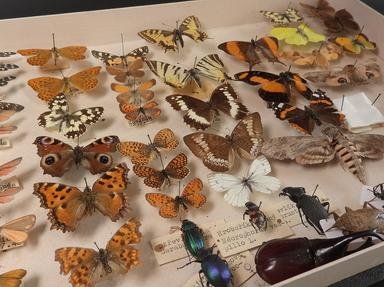Quiz Answer Key and Fun Facts
1. The other day I was cleaning out my empty water pitcher, when I noticed something jump inside it. It was extremely small; so small that I couldn't make out any features on it. It didn't seem to be able to fly, but sure liked jumping. What order do you think this creature is in?
2. Recently I moved to a new apartment. This apartment is really old and has tons of ants and fruit flies everywhere. This morning when I went to get the bread I found an insect crawling around it. I immediately assumed it was an ant (it was the same size), but on a closer look I found it wasn't. The body shape and antennae were similar to an ant, but the thing that stuck out most were a pair of rather long "pincers" coming off its abdomen. What order do you think this one is in?
3. A few years ago (2002) I was reading an article in a magazine that said scientists have discovered a new order of insects. I was really surprised. It's not everyday that a new order is discovered. The magazine said they are commonly called gladiators and they live in Africa. To which order do you think these creatures belong?
4. One of my biggest mix-ups was with what I thought was this insect. I later identified this specimen as a larva of a beetle (Coleoptera). It was small (~5cm), clear colored, and simple looking. It lacks eyes but has cerci. Its body is lobed and elongated. Most specimens of this order are actually much smaller, though one family, which I assumed this one was in, is larger and is called Japygidae. They are soil insects and are extremely small. In which order did I think this specimen was?
5. One of the tasks of my current job is to sort through insects that other people have collected. Lately I have been working on flight-intercept traps, designed to collect flying insects. By far the most common insect in these traps is this extremely small insect. It has four wings and a torpedo shaped body. The most interesting thing about these guys is that their wings are very thin but are surrounded by hairs. To which order do you think these insects belong?
6. Ever since I came to Miami University (in SW Ohio) I've heard stories of this one particular insect which plagued everyone the summer before I came to college (2004). This insect apparently came out in enormous numbers, covering everything. They aren't very small either (~30mm). They don't bite, but do a good job at scaring everyone who knows little about insects. What family are these insects in?
7. The other day my girlfriend and I were out by a stream looking for bugs, of course. One of the most common bugs we found on the water were of this family. They have a unique ability to stand on water. You may have seen them running around in small bodies of water like streams and ponds. What family is this?
8. Although in general I hate flies, I found this one really cool looking one. I found it in my dorm last year, in one of the bathrooms in the basement. At first I wasn't sure it was a fly since it had fuzzy body. Its antennae were long too. If I didn't take a closer look I would have said it looked like a moth. To which family of flies do you think this insect belongs?
9. This insect is one of my favorites. The specimen I found was actually inside my dorm (this happened with a lot of random insects) but usually lives outside. I liked it since it was really colorful, and I found out most of these were extremely colorful. It had a hard shell on its back too. The most unique thing is that it had antennae which were longer than their entire body length which I hadn't seen in similar insects. Which family do you think this is?
10. Though in general I find butterflies and moths rather boring, I once found a really cool looking one. It was at night. It was the largest moth I had ever seen and in fact this family contains the largest (in area) of any insects. This one was bright, lime green and had two tails. It was also really fuzzy. Which family do you think this specimen was in?
Source: Author
theskink
This quiz was reviewed by FunTrivia editor
crisw before going online.
Any errors found in FunTrivia content are routinely corrected through our feedback system.
